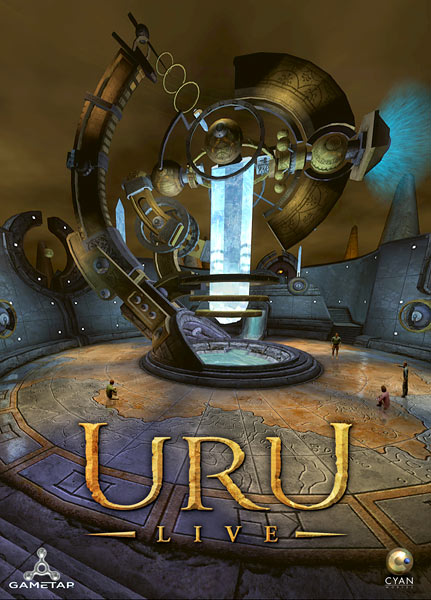
 Every
great game series has a creator that started it all, and the Myst series
is no exception. Cyan Worlds, Inc. (originally just Cyan, Inc.) was started
by brothers Rand and Robyn Miller in 1987, and generally made games for children,
beginning with cult classics The Manhole, released in 1988, Cosmic
Osmo and the Worlds Beyond the Mackerel, released in 1989, and Spelunx,
released in 1992. All were typical puzzle-adventure games similar to the Reader
Rabbit series. Eventually, however, the Miller brothers grew tired of making
simple children’s point-and-click games, dreaming of a game that was similar
to Spelunx and Cosmic Osmo, but for older gamers. In this
game, players would travel between different worlds, solving puzzles and unraveling
a mystery as nebulous as the main world of the game itself. The game, they decided,
would be called Myst, inspired by the Jules Verne novel The Mysterious
Island, to reflect the surreal environment they sought to create.
Every
great game series has a creator that started it all, and the Myst series
is no exception. Cyan Worlds, Inc. (originally just Cyan, Inc.) was started
by brothers Rand and Robyn Miller in 1987, and generally made games for children,
beginning with cult classics The Manhole, released in 1988, Cosmic
Osmo and the Worlds Beyond the Mackerel, released in 1989, and Spelunx,
released in 1992. All were typical puzzle-adventure games similar to the Reader
Rabbit series. Eventually, however, the Miller brothers grew tired of making
simple children’s point-and-click games, dreaming of a game that was similar
to Spelunx and Cosmic Osmo, but for older gamers. In this
game, players would travel between different worlds, solving puzzles and unraveling
a mystery as nebulous as the main world of the game itself. The game, they decided,
would be called Myst, inspired by the Jules Verne novel The Mysterious
Island, to reflect the surreal environment they sought to create.
After the huge success of Myst, the fans became eager for another addition
to the series, and Cyan delivered. Riven: The Sequel to Myst, the second
game in the series and widely thought to be the best of the games among Myst
fans, was released in 1997 to much hype and anticipation. Critics once again
scoffed and rolled their eyes, but the fans were eager to play this newest addition.
Riven was more intricate and challenging than Myst, and it
didn’t have as many Ages to explore as Myst did. The player didn’t
even link as often as they did in Myst. The game came on five disks,
requiring the player to switch whenever they reached a new island. Many fans
complained that this disrupted the flow of the game, but many others didn’t
mind one bit. Riven eventually became the best-selling game of 1997.
Around this same time, Cyan made big strides in their level of work. They hired
several new programmers to work on various aspects of the game and upgraded
their programs to handle the new technology. The crew began to use more blue screen, live-action footage to increase
the feel of the game. Cyan also introduced more aspects of the culture of Atrus’
people, the D’ni, including a language created by Richard A. Watson (affectionately
known as RAWA by Myst fans). The D’ni language is so ingrained
in the culture of Myst fans that many of them can read, speak and write
it to some degree, and more extreme fans even study it!
technology. The crew began to use more blue screen, live-action footage to increase
the feel of the game. Cyan also introduced more aspects of the culture of Atrus’
people, the D’ni, including a language created by Richard A. Watson (affectionately
known as RAWA by Myst fans). The D’ni language is so ingrained
in the culture of Myst fans that many of them can read, speak and write
it to some degree, and more extreme fans even study it!
A few years later, Robyn Miller decided to leave Cyan to pursue other interests,
leaving the company without a composer! Rand Miller took over the company and
decided to take it in a different direction, renaming Cyan to Cyan Worlds. Rand
and the rest of the crew continued to work on the Myst games, eventually
coming up with two. The first would be a sequel to Riven that would
break even more rules about the Adventure gaming genre. The second would be
a spin-off that also broke bounds, but would explore more of the D’ni
culture. Cyan Worlds began to develop both, but eventually discovered that they
couldn’t handle two at a time and tried to offer the game to various companies.
Presto Studios, known for creating the Journeyman Project series,
eventually took the job and began working on the next game in the Myst
series, Myst III: Exile.
Exile took things to a far different level. Presto Studios, under the
direction of Cyan Worlds, came up with a very dark storyline, easier puzzles
than Riven, and a new way to look at the game worlds by allowing 360-degree
camera movement. Now the player could look around to see where they were, use
it to discover previously unseen clues and hints, and even turn to look behind
them if the eerie atmosphere made them nervous. Exile was released
in 2001 for the PC and in 2002 for other game consoles. It wasn’t as big
of a seller as Myst and Riven were, but it was still a hit
with Myst fans and newcomers to the series alike for its superior graphics,
sound, and steady plot revelation. Many fans, however, had a mixed reaction
to the game. The more serious fans loathed Cyan Worlds for allowing another
company to make the game, even going so far as to say that Exile wasn’t
a part of the Myst series! More open-minded fans, however, took the
game very positively. This dispute divided the fans and caused a great deal
of tension until Cyan Worlds explained that they were working on a new Myst
game and couldn’t do both things at once. The problem was solved, but
there is still some dispute between Riven and Exile fans today.
Cyan Worlds’ other project, Uru: Ages Beyond Myst,
took a far different turn. The game strayed from first-person and became third
person, allowing the player to customize their character’s look. The game
also went into real time 3D for the graphics, which means that the graphics
were not still, ‘slideshow’ images anymore. Uru also delved
far deeper into D’ni culture, taking place mostly in the  abandoned
underground D’ni city. Originally, Uru was to come with access
to an online version of the game called Myst Online: Uru Live, but
this didn’t happen. Uru Live was later developed into a game
and released on Gametap, but it was recently cancelled. Cyan Worlds planned
to resurrect the game a third time, to mixed reception from Myst fans,
but this also failed, resulting in Cyan Worlds releasing the code to the fans
and leaving it up to them to revive Uru Live.
abandoned
underground D’ni city. Originally, Uru was to come with access
to an online version of the game called Myst Online: Uru Live, but
this didn’t happen. Uru Live was later developed into a game
and released on Gametap, but it was recently cancelled. Cyan Worlds planned
to resurrect the game a third time, to mixed reception from Myst fans,
but this also failed, resulting in Cyan Worlds releasing the code to the fans
and leaving it up to them to revive Uru Live.
Uru wasn’t as lucky in the market as Exile was. Although
it was received positively, fewer copies were sold of Uru than of the
previous three games, making this game a commercial failure for Cyan Worlds.
Myst fans, however, embraced the game with open arms, making Uru
a cult classic and creating a subculture of Myst fans who call themselves
Explorers. Two expansion packs were also released for Uru, Uru:
To D’ni and Uru: The Path of the Shell, which added unreleased
content to the games that Cyan Worlds had initially been saving for the first
attempt at launching Uru Live. Both expansion packs were also received
quite positively.
Unfortunately, Presto Studios soon closed their doors after making Myst
III: Exile, leaving Cyan Worlds once again without a company for their
next game. Still busy with Uru and the then in-development Uru
Live, Cyan Worlds was too busy to make the next game, Myst IV: Revelation.
Once again in want of a developer, Cyan Worlds turned to DreamForge to make
the game. The company eagerly accepted the game and began development. DreamForge’s
version of Revelation would’ve been in real time and used more
computer-generated characters than the previous titles, but Ubisoft, who by
then had acquired the rights to the Myst franchise, shut them down
after two years of development. Ubisoft then began to redesign the game from
scratch. Cyan Worlds set down a list of rules for Ubisoft to follow and let
them have at it.
Revelation was a success, for the most part. It received great praise
for its graphics, story, and puzzles. Immersion for this game was key, as demonstrated
by its ALIVE game engine – trees swayed in the breeze, animals interacted
with you, water moved realistically, and the clouds in the sky moved. The game
also added light effects, such as a lens flare when the player looked up at
the sun. While positively received, many critics disliked the steep technological
needs for the game – Revelation was the first of the Myst
games to come exclusively on DVD-ROM, meaning that the player needed a DVD-ROM
drive in order to play it, and once installed, the game took up over seven gigabytes
of space on the computer’s hard drive! This meant that in order to play
Revelation, the player’s computer had to be very up-to-date.
Even then, the game often had problems if the computer’s graphics card
couldn’t handle the heavy needs the game required. A patch was eventually
released to fix this problem and is still available if you really search for
it.
At this point, Cyan Worlds began to have financial issues. With the critical
flop that was Uru and the slowly-developing Uru Live, they
could no longer afford to continue making computer games as they once did. Rand
Miller decided to give the series one more shot and came up with a new, real
time game based off of unused Uru content. Myst V: End of Ages
was, and had to be, the final game of the Myst series, and was announced
as such.
End of Ages was well-received as a fitting end to the Myst
series. The step into real-time territory was noted by many reviewers, and the
music was also praised, but many thought the graphics and  immersion
level fell short of what players had come to expect from the series. Gone were
the non-story line items that the player could interact with, as they did in
Revelation. Gone was the sound of the player’s footsteps as they
walked to the next spot. The characters were computer-created models that used
a new technology to map the voice actors’ faces onto the base.
immersion
level fell short of what players had come to expect from the series. Gone were
the non-story line items that the player could interact with, as they did in
Revelation. Gone was the sound of the player’s footsteps as they
walked to the next spot. The characters were computer-created models that used
a new technology to map the voice actors’ faces onto the base.
After the release of End of Ages, the financial issues became too large
for Cyan Worlds to keep up with, and in late 2005, the company decided that
it was time to close its doors. Rand Miller laid off all but two employees and
announced to the press that Cyan Worlds was ceasing software development. Two
weeks later, however, Rand Miller managed to pull the Cyan Worlds team back
together and began working on a new game, Cosmic Osmo’s Hex Isle,
along with focusing more on Uru Live, which finally launched on Gametap
in 2007. The game unfortunately only lasted for a year and was taken down in
early 2008.

With all of this history behind them, the big question now is “Where is
Cyan Worlds going today?” Cyan Worlds recently regained the rights to
Uru Live and planned to relaunch it as MORE, or Myst Online: Restoration
Experiment, but this ultimately failed and Cyan Worlds has given the task to
its fans in the form of open-source code. The company did plan on starting a
new series called Latus, but this is now thought to be cancelled. Rand
Miller has stated that he is attempting to move away from the legacy of Myst,
and who can blame him? Myst is the kind of series that few others can
top, even with merchandise, devoted fans, and stunning gameplay of their own.
No matter what you think about the Myst series, there is one undeniable
fact that neither critics nor fans can ignore: Myst set a great example
for and changed the rules of the video game industry, one that many games still
follow and aspire to today.